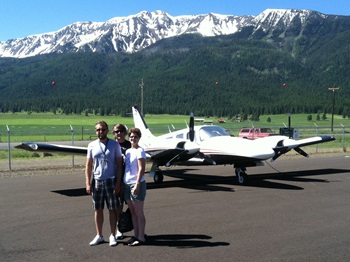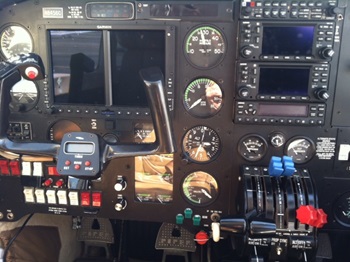The Aircraft Spotlight feature looks at an airplane type and evaluates it across six areas of particular interest to flying clubs and their members: Operating Cost, Maintenance, Insurability, Training, Cross-Country, and Fun Factor.

Operating Cost (2.5 stars)
Flying an aircraft with two engines is going to cost more, but the speed, comfort, and peace of mind of having a second engine will likely outweigh cost considerations if it’s something your members can afford. Ponderosa rents the Seneca for $310 an hour, Hobbs time wet, or a block of five hours for $290 per hour.
Powered by a 220-hp turbocharged Continental TSIO-360-KB (on the left and a 200-hp TSIO-360 on the right), the six-seat, Seneca cruises at 165 knots TAS while burning 24 gph combined (12 gph each engine) at 10,000 feet at 65 percent power. If you climb up to the flight levels, you can expect speeds closer to 200 knots true, according to Jon-Michael. He did note, “We are a club so people tend to want to push the power forward a little bit and if they’re not really careful on the mixtures we ca
Piper began production of the Seneca in 1971 and the purchase price ranges from as low as $70,000 for an early model Seneca I or II, to $250,000 for a mid-1990s Seneca IV. Newer Seneca Vs will be more expensive. Many Seneca IIs and IIIs are in the $125,000 to $175,000 range.
Maintenance (2.5 stars)
Piper has been making Senecas for a long time and the parts have never been difficult to come by and have not been particularly expensive, Jon-Michael said. It has standard continental engines and an annual is about $2,500 to $3,000.
However, “I always tell everyone that having twice as many engines costs three times as much to fix,” Jon-Michael said. “It’s just because now that we’ve introduced a second system, we’ve actually introduced a third system, which is how to switch between the two systems. Everything in the airplane seems to be more complicated and more difficult to get to. I actually heard one of our mechanics laughing behind me saying it’s true for that reason alone.”
Insurability (3 stars)
Ponderosa has a very good relationship with its broker and getting insurance was no problem. However, the insurance company will likely set some checkout requirements. Ponderosa’s members must have 350 hours minimum with an IFR rating, 50 hours multi-engine, and 10 hours in type. If you are a multi-engine student, instead of 50 hours of multi-engine time, you need 15 hours of dual in the named aircraft. The club has its own requirement that members must take an annual flight test with a club instructor or if it’s been more than 90 days since a member’s last flight, they must fly with an instructor first.
Training (4 stars)
Training is the primary reason to add a twin to your fleet and several members have joined Ponderosa just to get their multi-engine rating. The Seneca is “an easy trainer and tends to be a very likable trainer for many flight schools,” William said. “As a training aircraft they are a very stable, very docile aircraft. Their stall characteristics are very gentle and they do have the counter-rotating propellers. In the training environment that means we can kill either engine for training, but it also makes the yawing tendencies with the asymmetric thrust very controllable and manageable.”
Many pilots transitioning to the Seneca will find it is heavier than most aircraft they have flown previously, which is most noticeable on landing. Also the turbo system with its fixed waste gates is likely new for most pilots, so it’s important to really understand how the system works or you can over boost.

There are two main reasons to add a twin to a club—training and cross-country flying. Many pilots want the added safety of the second engine for longer flights and the Seneca is designed to go up high and get you where want to go.
With a useful load of 1,500 pounds and 128 gallons of fuel it has a range of 700 to 800 nm in economy cruise. If you want to get to your destination a little faster, the range drops to about 600 nm. Jon-Michael notes that the fuel will take up much of the useful load if you’re going with full tanks. Most of the members traveling with the aircraft are utilizing the plane for its bigger fuel tanks, “which last longer than your bladder will.”
The plane has a glass panel with a Garmin 600 suite, two Garmin 430 GPS, and EDM 760 engine monitor. It also has a service ceiling of 25,000 feet and an oxygen system, so it can get you over the weather and is well equipped if you do encounter IMC. And don’t forget it’s a bigger airplane, which is comfortable to fly in, whether you have two people and bags or if you’re utilizing the club seating for six.
Fun Factor (3 stars)
It’s always fun flying a well-maintained aircraft and Ponderosa’s Seneca is certainly an example of that. But Sharki finds the additional complexity of a twin one of the things that she enjoys most about the airplane. “There are more
systems – I tend to get bored with a Cessna 172. I recently transitioned to an Arrow and soon that won’t be enough,” she said. “There’s more to do and for those pilots who can’t get enough of something, the Seneca offers something else.”
Jon-Michael added, “There are a lot of knobs in a Seneca and the first time you sit down, the six different knobs on the throttle quadrant can be intimidating…but boy is it fun to push all six knobs forward.”
“It’s a beautiful plane,” Sharki said. “And it really is fun to fly.
Overall (3 stars)
Adding a twin to your fleet is a specialty aircraft that will help distinguish your club and could prove to be a good marketing tool. Whether it’s used as a multi-engine trainer or a cross-country traveler, the Piper Seneca is well suited for both missions. While a twin is more expensive to operate than a single engine, the Seneca is a popular aircraft that has been around for 40 years, making it easy to service. In the right club environment it will certainly get plenty of use.